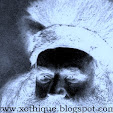The Third Fontana Book of Great Horror Stories, edited by Christine Bernard, from 1968, with a psychedelic, anamorphic photo for the cover, is one of many (mostly) solid horror anthologies from a grand era in the 1960s and 70s. My copy looks to have been heavily read and consulted, so much so that the cover is separate from the book.
Among the stories is one of August Derleth's "posthumous collaborations" (i.e. a Derleth story based on the flimsiest association with a note or story germ) with H.P. Lovecraft, The Shuttered Room. I hadn't read any of the "posthumous collaborations" in many years, though I read the Arkham House anthology The Watchers out of Time and other stories in various places a long time ago. Made into a film as well, the story is a fun as a light read, though possessing little or none of the controlled atmosphere and intellectual depth of Lovecraft's tales. The Shuttered Room cobbles together plot elements from both Lovecraft's The Dunwich Horror and The Shadow over Innsmouth, leaving out what's best about both short stories. At times the descriptions seem accidentally funny, as when Abner Whateley overhears dreadful events by eavesdropping on a party line.
The other eleven stories range from Roald Dahl's well-crafted suspense story "Poison," to Rudyard Kipling's "At the End of the Passage," which couples suspense and supernaturalism in an burningly hot colonial outpost, to stories of surreal, physical horror such as R.C. Cook's Green Fingers (wasn't that also a tv show with Eddie Albert and Eva Gabor?). Many of the titles alone are great -- take Henry James' The Romance of Certain Old Clothes, which bears influence from Hawthorne's tales.
E.F. Benson's The Room in the Tower is a disturbing interpenetration of dream and waking life; for me the brief description toward the climax, of the narrator "under the impression that some bright light had been flashed in my face" (apparently lightning) is particularly deft and unsettling, suggesting the loss of control one experiences in the state of nightmare. Although a few of the stories are slight, the book is for the most part a good anthology.


"A disturbing interpenetration of dream and waking life". I hope the stories are as well articulated as your review.
ReplyDeleteThanks for the good word Rob!
ReplyDelete